We have given these Class 12 Biology Important Questions Chapter 13 Organisms and Populations to solve different types of questions in the exam. Go through these Class 12 Biology Chapter 13 Important Questions, Organisms and Populations Important Questions & Previous Year Questions to score good marks in the board examination.
Class 12 Biology Chapter 13 Important Questions Organisms and Populations
Question 1.
Why are mango trees unable to grow in temperate climate? (Outside Delhi 2016)
Answer:
Mango trees are unable to grow in temperate climate because low temperature affects the kinetics of enzyme’s functioning and through this basal metabolism, activity and other physiological functions of the organism get affected.
Question 2.
Give an example of an organism that enters ‘diapause’ and why? (Delhi 2014)
Answer:
Many zooplanktons in lakes and ponds enter diapause so, as to escape unfavourable environmental conditions and to delay their overall development.
![]()
Question 3.
Mention how do bears escape from stressful time in winter? (Delhi 2013C)
Answer:
Bears escape from stressful time in winter by going into hibernation.
Question 4.
Write the basis on which an organism occupies a space in its community/natural surroundings. (All India 2013)
Answer:
An organism occupies individual or species level in its community. This level is occupied on the basis of ecological level of organisation or ecological hierarchy.
Individual → Population → Biotic community → Biome
Question 5.
How do seed bearing plants tide over dry’ and hot weather conditions? (All India 2013C)
Answer:
During unfavourable conditions, seed-bearing plants reduce their metabolic activities and undergo a state of dormancy. The seeds germinate under favourable moisture and temperate conditions.
Question 6.
Why are some organisms called as eurythermal and some others as stenohaline? (Foreign 2011)
Answer:
Organisms, which can tolerate and thrive in a wide range of temperature are called as eurythermal, while organisms, which can tolerate and thrive in a narrow range of salinity are stenohaline.
Question 7.
Why are green plants not found beyond a . certain depth in the ocean? (Delhi 2011)
Answer:
Beyond a certain depth, green plants are not found, because light is unavailable in that zone.
Question 8.
Mention any two activities of animals, which get cues from diurnal and seasonal variations in light intensity. (Delhi 2011c)
Answer:
The two activities of animals, which get cues from diurnal and seasonal variations in light intensity are
- Timings of their foraging
- Migratory activities
- Reproduction
Question 9.
How do animals like fishes and snails avoid summer related unfavourable conditions? (Delhi 2010)
Answer:
Fishes migrate and snails undergo into aestivation or summer sleep to avoid summer related problems.
Question 10.
How do prickles help cactus to survive in desert? Give two methods. (All India 2010C)
Answer:
The two methods by which prickles help cactus to survive in desert are
- By reducing and altering outer surface, they reduce evaporation and transpiration of water.
- By providing defence against grazing animals.
Question 11.
Plants that inhabit a rainforest are not found in a wetland. Explain. (Delhi 2016)
Answer:
Rainforest plants are not found in wetland as they have adapted to growing in very wet soil. The rainforest plants have a thin, smooth bark because they do not need thick bark to prevent moisture. The smoothness of the bark makes it difficult for other plants to grow on their surface. While in wetland, plants have roots in the soil under the water, but they grow above the water for respiration (pneumatophores).
Question 12.
Why the plants that inhabit a desert are not found in a mangrove? Give reasons. (Delhi 2016C)
Answer:
Desert plants are not found in a mangrove because in xerophytic (desert) condition, plant roots grow deeply to explore any possibility of underground water, lehves are highly reduced (spines) to minimise transpiration. While mangroves grow in marshy areas. Their roots grow vertically upwards from the soil for the absorption of oxygen from the atmosphere as the soil is poorly aerated. These roots are called pneumatophores.
Question 13.
Heat loss or heat gain depends upon the surface area of the organism’s body. Explain with the help of a suitable example. (All India 2016C)
Or
Why are small animals rarely found in the polar regions? Explain. (Foreign 2010)
Answer:
Small animals have a large surface area relative to their volume. So, they tend to lose body heat very fast during cold conditions. They need to spend more energy to generate body heat. Due to this, smaller animals are rarely found in polar regions.
Question 14.
How do mammals living in colder regions and seals living in polar regions able to reduce the loss of their body heat? (Delhi 2015C)
Answer:
Mammals living in colder climates generally have shorter ears and limbs to minimise heat loss. This is called Allen’s rule. In polar seas, aquatic mammals like seals have a thick layer of fat (blubber) below their skin that acts as an insulator and reduces loss of body heat.
Question 15.
Shark is eurythermal, while polar bear is stenothermal. What is the advantage the former has and what is the constraint the later has? (Delhi 2015C)
Answer:
The organisms that can tolerate and thrive in wide range of temperature are called eurythermal and those restricted to narrow range of temperatures are called stenothermal.
The levels of thermal tolerance of different species determine to a large extent their geographical distribution. Hence, eurythermal organisms (e.g. sharks) have vast geographical distribution as compared to stenothermal organisms (e.g. polar bears) that are limited to certain areas only.
Question 16.
Many freshwater animals cannot survive in marine environment. Explain. (Delhi 2015)
Answer:
Sea water contains high quantity of salt that is not favourable for freshwater animals. They face osmotic problems, hence they cannot survive in sea water for long.
![]()
Question 17.
When you go for a trek/trip to any high altitude places, you are advised to take it easy and rest for first two days. Comment, giving reason. (Foreign 2015)
Or
Why do people suffer from altitude sickness after reaching the high altitude regions? How does their body acclimatised after a couple of days? (Delhi 2015C)
Or
How does our body adapt to low oxygen availability at high altitudes? Foreign 2011
Answer:
When we go for a trip to any high altitude places, we are advised to take it easy and rest for first two days because we may suffer from high altitude sickness. A! low atmospheric pressure of high altitudes, body does not get enough oxygen, hence symptoms like nausea, fatigue start appearing. So, the body requires time to acclimatise to these conditions.
Some body adaptations at high altitudes are
- To compensate low oxygen, the production of red blood cells is increased.
- Faster breathing rate.
Question 18.
Some organisms suspend their metabolic activities to survive in unfavourable conditions. Explain with the help of any four examples. (Delhi 2012)
Answer:
Examples of organisms that suspend their metabolic activities in unfavourable conditions.
- Bacteria, fungi and lower plants They form thick-walled spores, which help them to survive in unfavourable conditions. Spores germinate on the return of favourable conditions.
- Higher plants Seeds and some other vegetative reproductive structures serve as the means to tide over periods of stress. They reduce their metabolic activity and undergo dormancy.
- Animals They undergo hibernation or aestivation, if unable to migrate, e.g. some snails and fishes.
- Zooplanktons They enter diapause (suspended development) under unfavourable conditions.
Question 19.
Explain the responses of all communities to environment over time. (All India 2011)
Answer:
Responses of communities to environment are
- Some organisms maintain homeostasis by physiological or behavioural means (regulate).
- The internal environment in majority of animals and nearly all plants change with the change of external environment (conform).
- Some organisms leave their habitats temporarily during unfavourable conditions and return back, when conditions become favourable (migrate).
- Some organisms suspend their metabolic activities to avoid stress by timely escaping, e.g. hibernation and aestivation. (1/2 x 4)
Question 20.
Bear hibernates, whereas some species of zooplanktons enter diapause to avoid stressful external conditions. How are these two ways different from each other? (Foreign 2011)
Answer:
Differences between diapause and hibernation is
| diapause | Hibernation |
| State of suspended development during | Process of spending winter’s extreme cold conditions in a dormant state. |
| e.g. zooplanktons. | e.g. some animals like bear. |
Question 21.
How do seals adapt to their natural habitat? Explain. (Foreign 2010)
Answer:
Seals adapt to the natural habitat (cold climate) by developing a thick layer of fat (blubber) below their skin that acts as an insulator and reduces excess loss of body heat,
Question 22.
Hummingbirds live among the bushes in tropics, while penguins live on icebergs. They cannot survive if their habitats are reversed. Justify. (Delhi 2010C)
Answer:
Hummingbirds live in their natural habitats (tropics). They have large surface area relative to their volume. So, they tend to lose heat very fast, even when it is warm outside.
Penguins live on icebergs (natural habitat). They have less surface area to volume ratio. The lesser the ratio, more effective will be the thermoregulation. Also, they hide in group to escape from cold conditions. Therefore, both of them will not survive, if their habitat are reversed.
Question 23.
(i) ‘Organisms may be conformers or regulators.’ Explain this statement and give one example of each.
(ii) Why are there more conformer than regulators in the animal world? (All India 2017)
Answer:
(i) Organisms may be regulators or conformers depending upon the response they show against abiotic stresses.
Regulators are organisms that have the ability to maintain a relatively constant internal environment by physiological and behavioural means.
These organisms ensure a constant body temperature (thermoregulation), constant osmotic concentration (osmoregulation), etc.
For example, in all birds, mammals, etc., sweating occurs profusely and the evaporation brings down the temperature of the body during summers.
Conformers Some organisms cannot.maintain a constant internal environment, i.e. their osmotic concentration and body temperature changes with the ambient surrounding. Such organisms are called as conformers. In aquatic animals such as Asterias, the osmotic concentration of body fluids changes according to the osmotic concentration of the surrounding water.
(ii) In the animal world, conformers are more than the regulators because thermoregulation is energetically expensive for many organisms. This is specially true for small animals like shrews and hummingbirds. Heat loss and heat gain is a function of surface area. Since, small animals have a larger surface area relative to their volume, they tend to loose body heat very fast.
Question 24.
During a school trip to ‘Rohtang Pass’, one of your classmate suddenly developed ‘altitude sickness’. But, he/she recovered after some time.
(i) Mention one symptom to diagnose the sickness.
(ii) What caused the sickness?
(iii) How could she/he recover by her/himself after some time? (Delhi 2016)
Answer:
(i) The primary symptoms of ‘altitude sickness’ are headache, nausea, fatigue, etc.
(ii) Sickness was caused due to the low atmospheric pressure prevailing at high altitude. Due to this, the body gets deprived of sufficient oxygen.
(iii) Ascending slowly is the best way to avoid altitude sickness. This way the body compensates low oxygen availability by increasing red blood cells production, decreasing the binding capacity of haemoglobin and by increasing breathing rate. Thus, she/he recovers by herself after some time.
Question 25.
Why do tribes who live in high altitude of Himalayas experience discomfort in respiration? How do they get adapted to survive in such a situation? (All India 2015C)
Answer:
The tribes who live in the high altitudes of Himalayas, experience discomfort in respiration because of the low atmospheric pressure prevailing there. Due to this, the body gets deprived of sufficient oxygen. The body copes up with the low oxygen stress by the following adaptations
- Increasing red blood cell production.
- Decreasing the binding affinity of haemoglobin.
- increasing the breathing rate.
Question 26.
In certain seasons we sweat profusely, while in some other season we shiver. Explain. (Delhi 2016C)
Answer:
In certain seasons, we sweat profusely while in some other season we shiver to maintain homeostasis. Homeostasis ensures constant body temperature and constant osmotic concentration of the body. It is maintained by following means. Human body maintains constant body temperature (37°C) by following way.
In summers, the outside temperature is very high than our body temperature. Due to this, profuse sweating occurs. This causes evaporation and cooling effect on the body.
In winters, the outside temperature is much lower than our body temperature. This causes shivering, a kind of exercise that produces heat and raises the body temperature.
Question 27.
Explain with the help of suitable examples the three different ways by which organisms overcome their stressful conditions lasting for short duration. (Delhi 2016)
Or
Explain by taking three different examples how do certain organisms pull through the adverse conditions when unable to migrate under stressful period. (Delhi 2016C)
Answer:
Organisms either migrate or suspend their metabolic activities, when conditions are stressful for short duration.
However, in the absence of migration, following mechanisms Help an organism to overcome adverse conditions
- Metabolic activities are reduced to undergo a state of dormancy, e.g. higher plants.
- Hibernates (frogs) or aestivates (snails) or undergo diapause (zooplanktons).
- Thick-walled spores are formed in stressful conditions and germinate under suitable conditions, e.g. bacteria, fungi and lower groups of plants.
![]()
Question 28.
Why are certain organisms called regulators or conformers? Explain with the help of one example of each. (All India 2016C)
Answer:
Some organisms are called conformers because they cannot maintain constant internal environment, e.g. lower organisms. On the other hand, certain organisms are called regulators as they can maintain their internal environment in response to external conditions, e.g. humans.
Question 29.
How do snails, seeds, bears, zooplanktons, fungi and bacteria adapt to conditions unfavourable for their survival? (All India 2015)
Or
How do organisms like fungi, zooplanktons and bears overcome the temporary short-lived climatic stressful conditions? Explain. (All India 2010)
Answer:
Ways to adapt to unfavourable conditions are
- Snails undergo aestivation (summer sleep) to avoid summer related problems.
- Bears undergo hibernation during winter.
- Zooplanktons enter a stage of suspended development called diapause.
- Bacteria and fungi slow down their metabolic rate and form a thick-walled spores to overcome stressful conditions. These spores germinate after the onset of suitable environment.
- Seeds undergo a state of dormancy during unfavourable conditions and germinate under favourable conditions.
Question 30.
(i) State how the constant internal environment is beneficial to organisms.
(ii) Explain any two alternatives by which organisms can overcome stressful external conditions. (All India 2014)
Answer:
(i) Constant internal environment (homeostasis) is beneficial to organisms as it permits all biochemical reactions and physiological functions to proceed with its optimum efficiency, thereby enhancing the overall efficiency of an organism under wide geographical range.
(ii) The two alternatives by which organisms can overcome stressful external conditions are
- Migration Organisms move temporarily to a favourable area under stressful conditions and return back when the period is over.
- Hibernation and aestivation are ways to escape the stress during winters and summers, respectively.
Question 31.
Water is very essential for life. Write any three features both for plants and animals, which enable them to survive in water scarce environment. (Delhi 2012)
Answer:
Three features in plants and animals that enable them to survive in water scarce environment are as follows
Adaptations in Plants
- Thick cuticle on their leaf surface.
- Stomata are arranged in deep pits (sunken) to minimise water loss through transpiration.
- Leaves are reduced to spines. The photosynthetic function is carry out by thick, fleshy, flattened stems.
Adaptations in Animals
- Kangaroo rat meets the water requirement through internal oxidation of fats. They concentrate their urine, so that minimum volume of water is excreted.
- Snails undergo aestivation during summers.
Question 32.
The following graph represents the organismic response to certain environmental condition (e.g. temperature)
(i) Which one of these A or B depicts conformers?
(ii) What does the other line graph depict?
(iii) How do these organisms differ from each other with reference to homeostasis?
(iv) Mention the category to which humans belong. (All India 2009)

Answer:
(i) A depicts conformers.
(ii) The other line B depicts regulators.
(iii) Differences between conformers and regulators are
| Conformers | Regulators |
| These cannot maintain a constant internal environment and change according to the ambient atmospheric conditions. | These organisms maintain a constant internal environment despite changes in the environment. |
| They show a narrow range of distribution. | They show a much wide range of distribution. |
(iv) Humans are regulators.
Question 33.
(i) Following are the responses of different animals to various abiotic factors. Describe each one with the help of an example.
(a) Regulate
(b) Conform
(c) Migrate
(d) Suspend
(ii) If 8 individuals in a population of 80 butterflies die in a week, calculate the death of population of butterflies during that period. (2018)
Answer:
(a) Regulate Some organisms are able to maintain a constant body temperature and osmotic concentration despite change in the external environment. All birds and mammals and a very few lower vertebrate and invertebrate species are capable of such regulation by physiological adjustment through thermoregulation and osmoregulation.
For example, most of the mammals regulate their body temperature to about 37°C. The body may respond to it by sweating (at high temperatures) and shivering (at low temperatures). Most reptiles regulate their body temperature by staying in burrows during summer and by basking in sun during winters. However, plants do not have such mechanisms to maintain an internal temperature.
(b) Conform A majority of organisms cannot maintain a constant internal environment, i.e. their osmotic concentration and their body temperature change with their environment (ectotherms). Such organisms are conformers. The efficiency of conformers is reduced under stressful conditions. Conformers had not evolved mechanisms like regulators because thermoregulation and osmoregulation mechanisms are energetically expensive for many small-sized organisms.
(c) Migrate The organisms can move away temporarily from the stressful habitat to a more favourable one. They return back when the unfavourable (stressful) period is over.
(d) Suspend To survive under unfavourable conditions, the organisms like bacteria, fungi and lower plants produce various kinds of thick-walled spores, which germinate on availability of suitable environment. Similarly higher plants, produce dormant structures like seeds to cope up with unfavourable conditions. In case of animals, if the organism is unable to migrate, it avoids unfavourable conditions by escaping in time. During unfavourable conditions, zooplanktons may enter a stage of suspended development, termed as diapause.
(ii) Refer to Answer No. 18 (Topic 2).
Question 34.
(i) Explain giving reasons why the tourists visiting Rohtang Pass or Mansarovar are advised to resume normal active life only after a few days of reaching there.
(ii) It is impossible to find small animals in the polar regions. Give reasons. (All India 2012)
Answer:
(i) Tourists visiting to Rohtang Pass near Manali (> 3500 m) may suffer from altitude sickness. They resume normal active life only after, a week because in low atmospheric pressure at high altitudes, the body does not get enough oxygen.
Gradually, the body compensates low oxygen availability by
- Increasing red blood cell production.
- Decreasing the binding affinity of haemoglobin.
- Increasing the breathing rate.
(ii) For reasons why small animals are not found in polar regions, Refer to Answer No. 13.
Question 35.
Mention the term used to describe a population interaction between an orchid growing on a forest tree. (Delhi 2019)
Or
What is an interaction called when an orchid grows on a mango plant? (Delhi 2012)
Answer:
An orchid growing on the branch of a mango tree is an epiphyte. Epiphytes are plants growing on other plants which however, do not derive nutrition from them and use them only for support. Hence, the relationship between a mango tree and an orchid is an example of commensalism.
Question 36.
Provide an instance where the population size of species can be estimated indirectly, without actually counting them or seeing them. (Delhi 2016C)
Answer:
Tiger population in National Parks is calculated on the basis of pugmarks and faecal matter.
![]()
Question 37.
Name the interaction that exists between sucker fish and shark. (Delhi 2016C)
Or
Name the type of interaction that exists between barnacles and whale. (Delhi 2015C)
Answer:
Sucker fish and shark show commensalism. Other example includes whale and barnacles growing on its back.
Question 38.
State the type of interaction that exists between ticks and dogs. (All India 2015C)
Or
Name the interaction that exists between Cuscuta and shoe-flower plant. (Delhi 2015C)
Answer:
The type of interaction that exists between ticks and dog is parasitism. Ticks are ectoparasite.
Or
The interaction between Cuscuta and shoe-flower bush is called parasitism. Here, Cuscuta is the parasite, which infests the shoe-flower bush and derives nutrition from it.
Question 39.
Name the type of interaction seen between fig and wasps. (All India 2015C)
Answer:
Mutualism is the interaction that exists between fig and wasps.
Question 40.
Name the two intermediate hosts on which the human liver fluke depends to complete its life cycle, so as to facilitate parasitisation of its primary host. (Delhi 2014)
Answer:
The human liver fluke requires two intermediate hosts, i.e. freshwater snail and fish to complete its life cycle and facilitate parasitisation of its primary host.
Question 41.
State Gause’s competitive exclusion principle. (All India 2014)
Answer:
Gause’s competitive exclusion principle states that two competiting species for same resource cannot coexist, if all other ecological factors are constant.
Question 42.
Name the interspecific interactions in which one is detrimental while other is neutral. (All India 2013C)
Answer:
Amensalism, e.g. Penicillium produces toxin and kills bacteria, but the former does not get affected.
Question 43.
Write, what do phytophagous insects feed on? (Delhi 2012)
Answer:
Phytophagous insects feed on sap mainly, but can consume the other parts of plants as well.
Question 44.
Mention the unique feature with respect to flowering and fruiting in bamboo species. (Delhi 2012)
Answer:
Bamboo plants flower only once in their lifetime, generally after 50-100 years. They produce large number of fruits and then die.
Question 45.
In a pond, there were 20 Hydrilla plants. Through reproduction, 10 new Hydrilla plants were added in a year. Calculate the birth rate of the population. (Delhi 2012)
Answer:
The birth rate of Hydrilla
=\(\frac{\text { Number of individuals born }}{\text { Total number of individuals }}\)
= \(\frac { 10 }{ 20 }\) = 0.5 per Hydrilla plant per year.
Birth rate is 0.5 per Hydrilla plant or 500 per thousand/year.
Question 46.
Pollinating species of wasps show mutualism with specific fig plants.
Mention the benefits the female wasps derive from the fig trees from such an interaction. (All India 2011)
Answer:
The wasp uses the fig plant ovary for oviposition. It also uses the developing seeds of the fruit to nourish its larvae.
Question 47.
Why are cattle and goats not seen browsing on Calotropis growing in the fields? (Foreign 2011)
Answer:
Cattle or goat do not graze on Calotropis plant because it produces poisonous cardiac glycosides.
Question 48.
In a pond, there were 200 frogs. 40 more were born in a year. Calculate the birth rate of the population. (Delhi 2010)
Answer:
The birth rate of frog population
= \(\frac { 40 }{ 200 }\) = 0.2 per frog/year
or 200 per thousand/year.
Question 49.
Why do predators avoid eating monarch butterfly? How does the butterfly develop this protective feature? (Foreign 2010)
Answer:
Predators avoid the monarch butterfly as it is highly distasteful to its predators (birds) because of a special chemical present in its body. It acquires this chemical during the caterpillar stage by feeding on a poisonous plant (milkweed).
Question 50.
Comment on the interaction between a clown fish living among the tentacles of a sea anemone. (Delhi 2010)
Answer:
The interaction between a clown fish living among the tentacles of sea anemone is called commensalism.
Question 51.
Comment on the interaction between certain species of fig trees and wasps. (Delhi 2010C)
Answer:
The relation between fig trees and wasps is mutualism.
Question 52.
If 8 individuals in a laboratory population of 80 fruitflies died in a week, then what would be the death rate for population for the said period? (Delhi 2010)
Answer:
Death rate = \(\frac{\text { Number of individual died }}{\text { Total number of individuals }}\)
= \(\frac { 8 }{ 80 }\) = 0.1 individuals/week 80
Death rate will be 0.1 individuals /week.
Question 53.
State Gause’s ‘competitive exclusion’ principle. How have the recent studies modified this principle? (All India 2019)
Answer:
Gause’s competitive exclusion principle states that two closely related species competing for the same resources cannot coexist indefinitely and the competitively inferior one will be eliminated eventually (true if resources are limiting). This principle has been modified to ‘complete competitors cannot coexist’ one of the primary ways niche-sharing species can coexist is the competition-colonisation trade-off. In simple terms, species that are better competitors will be specialists, whereas species that are better colonisers are more likely to be generalists.
Question 54.
Name and explain the interaction that is seen between clown fish and sea anemones. (All India 2019)
Or
Why dd clown fish and sea anemone pair up? What is this relationship called? (Delhi 2012; All India 2008)
Answer:
Clown fish maintains commensalism with the sea anemone. In this interaction, one species is benefitted and the other is neither harmed nor benefitted. Sea anemone has stinging tentacles that provide protection to clown fish from predators. The anemone does not appear to derive any benefit from the clown fish.
Question 55.
What is mutualism? Mention any two examples where the organisms involved are commercially exploited in agriculture. (All India 2015)
Or
Explain mutualism with the help of an example. (All India 2014)
Answer:
Mutualism is an interaction that confers benefits to both the interacting species. Two examples where organisms involved are commercially exploited in agriculture are
- Mycorrhizae represent a close mutual association between fungi and the roots of higher plants. Fungi help the plants in absorption of nutrients, specially phosphorus, while the plants provides food for the fungus.
-
Lichens represent an intimate mutualistic relationship between a fungus and photosynthesising algae or cyanobacteria.
Here, the fungus helps in the absorption of nutrients and provides protection, while algae prepare the food.
Question 56.
Koel is clever enough to lay eggs in a crow’s nest. Write the reason for this peculiar behaviour. Name the type of interaction. (All India 2015C)
Or
Mention the changes the koel must have undergone in order to achieve brood parasitism, during the course of evolution. (All India 2010C)
Answer:
Brood parasitism in birds is a fascinating example of parasitism in which the parasitic bird lay its eggs in the nest of its host and let the host incubate them.
During the course of evolution, the egg of the koel have evolved to resemble the host’s egg in size and colour to reduce the chances of the host bird, detecting the foreign eggs and ejecting them from the nest.
Question 57.
Draw the labelled diagrams of stable and declining age pyramids of human population. (All India 2015C)
Answer:
For stable and declining age pyramids of human population diagrams, Refer to figure 13.3 on page no. 325.
Question 58.
Describe the mutual relationship between . fig tree and wasp and comment on the phenomenon that operates in their relationship. (All India 2014)
Answer:
The relationship between fig tree and wasp shows mutualism. The wasp while searching for sites to lay its eggs, pollinates the fig’s inflorescence. On the other hand, the fig not only provides shelter (fruit) for oviposition to wasp, but also allows its larvae to feed on seeds.
Question 59.
Construct an age pyramid which reflects an expanding growth status of human population. (All India 2014)
Answer:
The age pyramid geometrically represents the proportions of different age groups (pre-reproductive, reproductive and post-reproductive) in population. The triangular shape of age pyramid represents the expanding growth status of human population, because it has maximum number of individuals in pre-reproductive age group.

Question 60.
Construct an age pyramid which reflects a stable growth status of human population. (All India 2014)
Answer:
The age pyramid that reflects a stable growth status of human population can be represented as follows
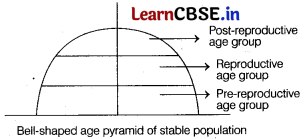
Question 61.
Differentiate between commensalism and mutualism by taking one example each from plants only. (All India 2014)
Answer:
Commensalism is the kind of interaction between species in which one is benefitted and other is neither benefitted nor harmed. Example of such association is orchid growing as an epiphyte on a mango tree, which remains unaffected by its growth.
Whereas mutualism is the type of interaction in which both the species involved are benefitted. e.g. lichen representing mutual association between algae and fungi, in which algae is protected by fungi, whi,ch also provides nutrients for synthesis of food, while algae provides food to fungi, as they are incapable of synthesising their own food.
![]()
Question 62.
Explain Verhulst-Pearl logistic growth of a population. (All India 2014)
Answer:
Verhulst-Pearl logistic growth is a type of population growth in which the population growing in a habitat with limited resources initially shows a lag phase, followed by exponential phase and finally a declining or stationary phase, when the growth or density of population reaches carrying capacity.
It can be explained by following equation
dN/dt = rN\(\left(\frac{K-N}{K}\right)\)
Where, N – Population density at time t
r – Intrinsic rate of natural increase
K – Carrying capacity
Question 63.
Apart from being a part of food chain, predators play other important roles. Mention any two such roles supported by examples. (Delhi 2014)
Answer:
Apart from being a part of food chain, predators play important role in
- Maintaining the prey population and regulate interspecies population.
- Indicating ecological disturbances as predators are small in number and highly sensitive to ecological changes owing to their excessive adaptation.
Question 64.
How does monarch butterfly defend itself from predators? Explain. (Delhi 2013C)
Answer:
For defence mechanism evolved by the monarch butterfly, Refer to Answer No. 15.
Question 65.
Explain brood parasitism with the help of an example. (All India 2012)
Answer:
The phenomenon in which one organism (parasite) lays its eggs in the nest of another organism is called brood parasitism.
For example, cuckoo (parasite) lays eggs which resemble the host’s (crow) egg in size and colour in crow’s nest and let it be incubated by them till they hatch and grow.
Question 66.
Why are herbivores considered similar to predators in an ecological context? Explain. (All India 2010)
Answer:
In ecological context, herbivores are considered similar to predators because they feed on plants and their products to meet their food requirements, just like predators, i.e. they feed on prey for their food.
Question 67.
How does the floral pattern of mediterranean orchid Ophrys guarantee cross-pollination? (Delhi 2010)
Answer:
In the flowers of Ophrys, one petal resembles the female of a bee species in size, colour, markings, etc. Male bee perceives it as a female and pseudocopulates with it.
During the process, the pollen grains from the anthers get dusted on the body of the bee. When the bee is attracted to another flower of this orchid species, the. process is repeated and the pollen grains from the body of the bee get dusted on the stigma, thus cross-pollination is achieved.
Question 68.
How do plants benefit from having mycorrhizal symbiotic association? (Foreign 2010)
Answer:
Benefits to plants having mycorrhizal symbiotic association are
- The fungus absorbs nutrients from the soil and passes it on to the plant.
- Mycorrhiza provides resistance to root-borne pathogens.
- They show increased tolerance to salinity and drought.
- An overall increase occurs in plant growth and development.
Question 69.
Explain the two defence mechanisms evolved in preys to avoid overpopulation of their predator. (All India 2010C)
Answer:
Defence mechanisms evolved in preys are
- To avoid being detected easily by the predators, some species of insects and frogs are cryptically coloured (camouflaged).
- Some plants have thorns or spines for defence mechanism, e.g. Acacia, cactus.
Question 70.
Study the graph given below and answer the questions that follows
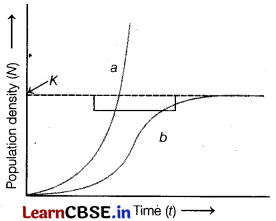
(i) The curve W is described by the following equation :
\(\frac { dN }{ dt }\) = rN \(\frac { K-N }{ K }\)
What does ‘K’ stand for in this equation? Mention its significance.
(ii) Which one of the two curves is considered a more realistic one for most of the animal populations?
(iii) Which curve would depict the population of a species of deer if there are no predators in the habitat? Why is it so? (All India 2019)
Answer:
(i) ‘K’ stands for ‘carrying factor’. The carrying capacity signifies the limit of habitat, i.e. limited resources in a given habitat to support growth upto a certain level beyond which no further growth can take palce.
(ii) The curve ‘V’ is considered a more realistic one for most of the animal populations. It is so, becasue in the curve ‘b’, the sources of food and space are limited and it supports the growth curve of animal populations.
(iii) The curve ‘b’ would depict the population of a species of deer, if there are no predators in the habitat. In the absence of predators, prey population will increase. Thus, the competition will increase due to the limited food and shelter resources within the prey population.
Question 71.
Mention the special adaptations evolved in parasites and why? (Delhi 2019)
Or
Explain parasitism and coevolution with the help of one example of each. (All India 2016)
Or
Explain coevolution with reference to parasites and their hosts. Mention any four special adaptive features evolved in parasites for their parasitic mode of life. (All India 2015C)
Answer:
Coevolution is a phenomenon where many parasites have evolved to be host-specific in such a way that both the host and parasite tend to co-evolve. If the host develops special mechanism to resist the parasite, the parasite also has to evolve the mechanisms to counteract the host’s resistance.
Many living organisms live as a parasite on host (plant or animals). Parasite ensures free-lodging and meals from the host and for this it evolves mechanisms to encounter and neutralise the resistance coming from host. This can be understood by the following examples
(i) Parasites evolve special adaptations like
- loss of’unnecessary sense organs.
- presence of adhesive organs like suckers.
- loss of digestive system.
- high reproductive capacity.
(ii) The host in turn evolves special mechanism for rejecting or resisting the parasite. So, when the parasite is not able to complete its life cycle on single host it finds alternative host or secondary host to complete their life cycle in order to perpetuate its species and ensures its own reproduction. Two examples are
- Liver fluke-hosts are man and snail.
- Malaria parasite-hosts are man and mosquito.
![]()
Question 72.
Explain brood parasitism with the help of an example. (Delhi 2016C; 2013C)
Answer:
For brood parasitism, Refer to Answer No. 31.
Question 73.
Explain Gause’s competitive exclusion principle with the help of a suitable example. (All India 2016C)
Answer:
Cause’s competitive exclusion principle Refer to Answer No. 7.
For example, The abingdon tortoise in Galapagos Islands became extinct within a decade after goats were introduced on the Island, apparently due to their greater browsing efficiency.
Question 74.
Predation is usually referred to as a detrimental association. State any three positive roles that a predator plays in an ecosystem. (All India 2016)
Or
What is ‘predation’? Explain with the help of suitable examples why is it required in a community with rich biodiversity. (All India 2015C)
Answer:
Predation is an interspecific interaction, where an animal, called predator, kills and consumes the other weaker animal called prey. Predation is natures way of transferring the energy fixed by plants to higher trophic level, e.g. a tiger (predator) eating a deer (prey), a sparrow (predator) eating fruit or seed (prey), etc.
Requirement of Predators
- Predators keep prey population under control. This is called biological control.
- Predators also help in maintaining species diversity in community by reducing the intensity of competition among prey species.
- Acts as ‘conduits’ for energy transfer across trophic level.
- Predators play other important roles, i.e. in the absence of predator species, prey species could achieve very high population densities and cause ecosystem instability, i.e the biological control of pests affected by predation.
Question 75.
Name and explain the type of interaction that exists in mycorrhiza and between cattle egret and grazing cattle. (All India 2016)
Answer:
Mycorrhiza It is an association between fungi and roots of higher plants. It is called mutualism. The fungi help plant in the absorption of essential nutrients from the soil, while in turn it provides the fungi with energy yielding carbohydrates. Both partners are benefitted.
The cattle egret and grazing cattle share commensalism type of relationship. The grazing cattle flush out insects from grass while grazing. So, it becomes easier for egret to catch and feed on them. In this, one partner gets benefit, while other remains unaffected.
Question 76.
Differentiate among mutualism, parasitism and commensalism. Provide one example for each of them. (Foreign 2015)
Answer:
Differences between mutualism, parasitism and commensalism are
| Mutualism | Parasitism | Commensalism |
| It benefits both the interacting species. | It benefits one species, while other species is harmed. | Interaction between two species, where one species is benefitted and the other is neither harmed nor benefitted. |
| Example Lichens represent mutualism between fungus and algae. | Example Cuscuta, tape worm and Plasmodium. | Example An orchid growing as an epiphyte on a mango tree. |
Question 77.
Study the graph given below and answer the questions that follows
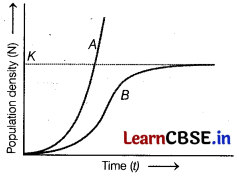
(i) Write the status of food and space in the curves (A) and (B).
(ii) In the absence of predators, which one of the two curves would appropriately depict the prey population?
(iii) Time has been shown on X-axis and there is a parallel dotted line above it. Give the significance of this dotted line. (Delhi 2014)
Answer:
(i) The status of food and space in curve A is unlimited resources, while in curve B the sources of food and space are limited.
(ii) In the absence of predators, the curve B would appropriately depict the competition for limited food and shelter resources within the prey population.
(iii) The dotted line in the above graph represents the carrying capacity (K).
The carrying capacity signifies the limit of habitat, i.e. limited resources in a given habitat to support growth upto a certain level beyond which no further growth can take place.
Question 78.
Construct the age pyramid which reflects growth status of human population. (All India 2014)
Or
Draw and explain expanding age pyramids of human population. Why is it so called? (All India 2014C)
Answer:
For expanding age pyramid, Refer to Answer No. 25.
Question 79.
Describe the mutual relationship between fig tree and wasp and comment on the phenomenon that operates in their relationships. (Delhi 2014)
Answer:
For relationship between fig tree and wasp, Refer to Answer No. 24.
Question 80.
(i) Write the importance of measuring the size of a population in a habitat or an ecosystem.
(ii) Explain with the help of an example, how the percentage cover is a more meaningful measure of population size than mere numbers. (All India 2013)
Answer:
(i) Measurement of population in a habitat determines the relative abundance of a particular species and its effect on the available resources of that particular habitat.
(ii) The percentage cover is more meaningful measure of population size than mere numbers because the relative abundance of a species is not only determined by number of individuals, but by both the relative abundance in biomass and number.
For example, in a unit area, the number of grass species or relative abundance in number is high, but not the relative biomass, if the same area has one or two Ficus benghalensts tree, it is very low in relative abundance, but high in relative abundance of biomass.
Question 81.
(i) Explain death rate in a population by taking a suitable example.
(ii) Write the other two characteristics, which only a population shows but an individual cannot. (All India 2013)
Answer:
(i) Death rate or Mortality is expressed as the number of deaths of individual of a population . per year. For example, if 80 individuals in a laboratory population of 800 fruitfly died in a week, then death rate is
\(\frac { 80 }{ 100 }\) = 0.1 per fruitfly/week
(ii) Characteristics of population, not exhibited by individual are
- Population size or Density.
- Population interactions.
Question 82.
(i) Explain birth rate in a population by taking a suitable example.
(ii) Write the other two characteristics, which only a population shows but an individual cannot. (All India 2013)
Answer:
(i) Due to natality or birth rate, population increases continuously. It is the production of new individual by birth, hatching or by asexual mode, etc. It is expressed as the number of birth per 1000 individuals of a population per year.
(ii) The characteristic, which are unique to the group (population) and not shown by an individual are
(a) Population dynamics theorise to explain population growth. Size of population for any species is not a static parameter. Population growth changes during time and depends upon food availability, predation, pressure, weather and also depends upon natality, mortality, immigration and emigration.
(b) Regulation of population governs population density or population size. It is the number of individuals of a species per unit , area or volume.
![]()
Question 83.
(i) List any three ways of measuring population density of a habitat.
(ii) Mention the essential information that can be obtained by studying the population density of an organism. (All India 2013)
Answer:
(i) Three ways of measuring population density of a habitat
A- Per cent cover for trees with larger canopy.
B- Number of fishes caught per trap.
C- Pug marks or faecal pellets for tiger census.
(ii) The population density tells us about the status of a species, i.e. the outcome of competition, impact of predation or effect of pesticides, etc.
Question 84.
Name the type of interaction seen in each of the following examples:
(i) Ascaris worm living in the intestine of human.
(ii) Wasp pollinating fig’s inflorescence.
(iii) Clown fish living among the tentacles of sea anemone.
(iv) Mycorrhizae living on the roots of higher plants.
(v) Orchid growing on a branch of mango tree.
(vi) Disappearance of smaller barnacles when Balanus dominated in the coast of Scotland. (Delhi 2011)
Answer:
(i) Parasitism
(ii) Mutualism
(iii) Commensalism
(iv) Mutualism
(v) Commensalism
(vi) Competition
Question 85.
Study the three different age pyramids, for human population given below and answer the questions that follows:
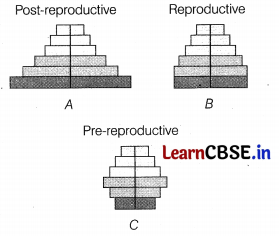
(i) Write the names given to each of these age pyramids.
(ii) Mention the one, which is ideal for human population and why. (Foreign 2011)
Answer:
(i) A – Expanding,
B – Stable
C -Declining
(ii) Stable population is ideal for human population. It is beneficial for the survival and better living of the human population. It is helpful for planning sustainable living.
Question 86.
(i) Study the flow chart given below and complete the equation that follows by identifying 1, 2, 3 and 4.
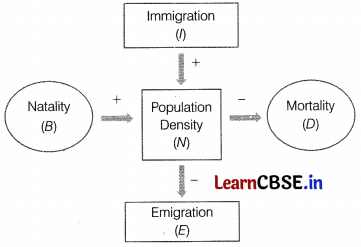
N
t + 1
= N
t
+ [( 1 + 2) – (3 + 4)]
(ii) Mention the different ways by which the population density of different species can be measured. (All India 2019)
Or
(i) Explain the equation
N
t + 1
= N
t
+ [(B + I) – (D + E)]
on the basis of the flowchart given below
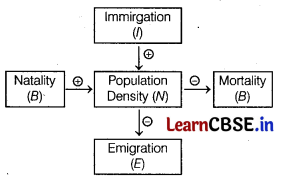
(ii) Mention the different ways by which the population density of different species can be measured. (Delhi 2011C)
Answer:
(i) If N is the population density at time t, then its density at time t + 1 is
N
t
+ [(B + I) – (D + E)]
The population density will increase if the number of birth and the number of immigrants, i.e. (B+ I) is more than the number of death and the number of emigrants, i.e. (D+E).
(ii) For different ways of measurement of population, density, Refer to Answer No. 49 (i).
Question 87.
(i) What is ‘population’ according to you as a biology student?
(ii) ‘The size of a population for any species is not a static parameter’. Justify the statement with specific reference to fluctuations in the population density of a region in a given period of time. (Delhi 2019)
Answer:
(i) Population is a set of individuals of a particular species which are found in a particular geographical area and can interbreed.
(ii) For the justification of the statement, Refer to text on page no. 325 and 326 (Population growth).
Question 88.
(i) The graph given below represents the organisms response to temperature as an environmental condition.
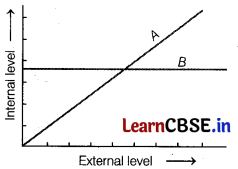
(a) Which one of the two lines represents conformers and why?
(b) What does the other line in the graph represent and why?
(ii) Mention the different adaptations the parasites have evolved with, to be able to successfully complete their life cycles in their hosts. (2018C)
Answer:
(i) (a) The line A depicts conformers. The conformers cannot maintain a constant internal environment and change according to the ambient atmospheric conditions.
(b) The other line B depicts regulators. The regulators maintain a constant internal environment despite changes in the environment.
(ii) For adaptations in parasites, Refer to Answer No. 37.
Question 89.
(i) Compare, giving reasons, the J-shaped and S-shaped models of population growth of a species.
(ii) Explain ‘fitness of a species’, as mentioned by Darwin. (All India 2017)
Answer:
(i) Differences between J-shaped and s-shaped model of population growth are
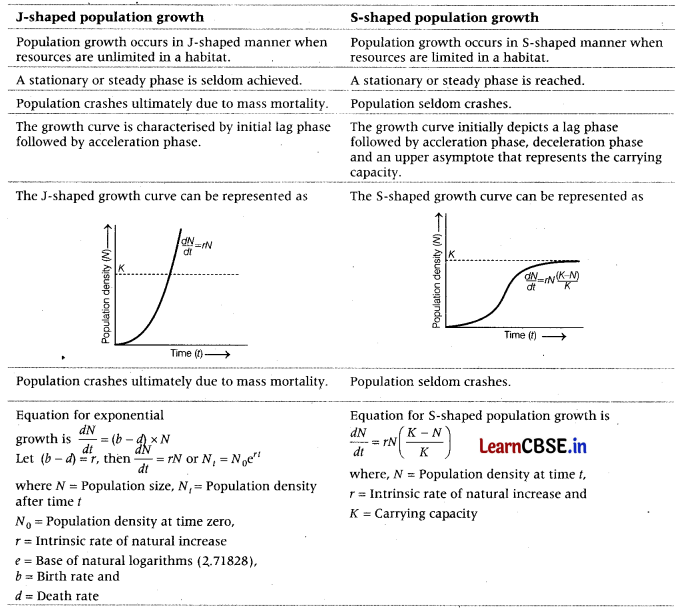
(ii) Fitness of a species as mentioned by Darwin Darwinian fitness (high Y value) states that the population evolves to maximise its reproductive fitness in the habitat where it lives. Under a particular set of selection pressure, organisms evolve towards the most efficient reproductive strategy. The rate of breeding varies from species to species. Some species breed only once in their lifetime (Pacific salmon fish and bamboo), while some breed many times in their lifetime (birds and mammals). Some organisms produce a large number of small-sized offspring (oysters), whereas other produce a small number of large-sized offspring (birds and mammals).
![]()
Question 90.
(i) What is an age pyraipid?
(ii) Name three representative kinds of age pyramids for human population and list the characteristics for each one of them. (Delhi 2017)
Or
(i) What is an age pyramid?
(ii) Explain with the help of figures, the three different types of age pyramids represented by human population. (Delhi 2011C)
Answer:
(i) Age pyramids When the age distribution (per cent individuals of a given age or age group) is plotted for the population, it is called age pyramid.
(ii) Population at any given time is composed of individuals of different ages. For human population, the age pyramids generally show age distribution of males and females in a combined diagram.
The shape of the pyramids reflects the growth status of the population that whether it is expanding (triangular-shaped), stable (bell-shaped) or declining (urn-shaped).
(a) Expanding or Triangular age pyramid In this, number of pre-reproductive individuals is very large, number of age reproductive individuals is moderate, while post-reproductive individuals are fewer. This type of age pyramid shows that population is growing. The rate of growth depends upon the size of pre-reproductive population. This type of population growth is observed in developing countries like India, Brazil.
(b) Stable or Bell-shaped age pyramid In this, the number of pre-reproductive and reproductive individuals is almost equal. Post-reproductive individuals are comparatively fewer. The population size remains stable, neither growing nor diminishing. This type of population growth is observed in countries like USA, Denmark.
(c) Declining or Urn-shaped age pyramid The proportion of reproductive age group is higher than the individuals in pre-reproductive age group. The number of post-reproductive individuals in also sizeable. It is declining or diminishing population with negative growth. This type of population growth is observed in countries like Japan.

Question 91.
(i) Represent diagrammatically three kinds of age pyramids for human populations.
(ii) How does an age pyramid for human population at given point of time help the policy makers in planning for future? (Delhi 2016)
Or
Analysis of age pyramids for human population can provide important inputs for long-term planning strategies. Explain. (Delhi 2015)
Answer:
(i) Refer to Answer No. 56 (ii). (3)
(ii) A policy maker works on population projection to assess future demand of food, water, energy as well as health and reproductive age. The age pyramids reflect several possible scenario of future of fertility and mortality.
At given point of time, the expanding age-pyramids for human population has more pre-reproductive and reproductive population and less post-reproductive population. Thus,
this type of age pyramids help the policy makers in planning for future economic growth of the country.
Question 92.
(i) Name the two growth models that represent population growth and draw the respective growth curves they represent.
(ii) State the basis for the difference in the shape of these curves.
(iii) Which one of the curves represents the human population growth at present? Do you think such a curve is sustainable? Give reason in support of your answer. (All india 2016)
Answer:
(i) The two growth models are
(a) Exponential growth curve
(b) Logistic growth curve.
(ii) Refer to Answer No. 55 (i).
(iii) The human population at present is represented by logistic growth curve. The logistic growth curve is sustainable because the biological factors and carrying capacity support it.
Question 93.
(i) What is population density? Why are ecologists interested in measuring it?
(ii) Write the different ways of measuring population density. Explain any two with the help of specific examples. (All India 2016C)
Answer:
(i) Population density means number of individuals present per unit area. It can be measured by determining the population size. Ecologists are interested in measuring population density for the following reasons
(a) The size of the population tells us a lot about its status in the habitat.
(b) Ecological processes such as outcome of competition with another species, the impact of a predator or the effect of pesticide application can be easily evaluated in terms of change in the population size.
(ii) The different methods to study population size are as follows
(a) Per cent cover or Biomass In an area with 200 Parthenium plants and only one banyan tree with large canopy, the denstiy of banyan tree is small, but does not reflect its important role in the community. Here the per cent cover or biomass is more meaningful method of assessing population density.
(b) Total number It involves the counting of organisms in the given area.
(c) Relative density In this method, there is no need to count the organisms individually, e.g. the number of fishes caught per trap gives the measure of their total density in a given waterbody.
(d) Indirect assessment The tiger census is based on pugmarks and faecal pellets.
Question 94.
(i) List the different attributes that a population has and not an individual organism.
(ii) What is population density? Explain any three different ways the population density can be measured, with the help of an example each. (All India 2015)
Answer:
(t) Population attributes are certain characteristics of a population.
Some of them are as follows
(a) Population size or Density is the number of individuals of a species per unit area or volume.
Population Density (PD) = \(\frac { Number of individuals in a region (N) }{ Number of unit area in the region (S) }\)
PD = \(\frac { N }{ S }\)
(b) Birth rate or Natality is expressed as the number of births per 1000 individuals of a population per year, e.g. if in a pond, there were 20 lotus plants last year and through reproduction 8 new plants are added then, Birth rate = \(\frac { 8 }{ 20 }\) = 0.4 offspring per lotus per year.
(c) Death rate or Mortality is expressed as the number of deaths per 1000 individuals of a population per year, i.e. if 4 individuals in a population of 40 fruitflies died during a specified time interval (say a week ) then,
Death rate = \(\frac { 4 }{ 40 }\) = 0.1 individuals per fruitfly per week.
(d) Sex ratio is expressed as the number of females and males per 1000 individuals of a population in a given time, e.g. 60% females and 40% males in population.
(e) Age pyramid When the age distribution (per cent individuals of a given age or age group) is plotted for the population, it is called age pyramid.
(ii) Refer to Answer No. 59. (2)
Question 95.
(i) Name the population growth pattern the equation {\(\frac { dN }{ dt }\) = rN} represents. What does ‘r’ represent in the equation? Write its importance in population growth.
(ii) Explain the principle of carrying capacity by using population Verhulst-Pearl logistic growth curve. (Delhi 2014C)
Answer:
(i) The logistic growth pattern is represented by equation {\(\frac { dN }{ dt }\) = rN}
Here ‘f’ represents the intrinsic factor (a rate of natural increase). Since, the growth for most of the organisms’s population becomes limiting due to limited resources, this logistic growth pattern provides a realistic model for study of population growth.
(ii) The Verhulst-Pearl logistic growth curve is explaned by \(\frac { dN }{ dt }\) = rN(\(\frac { K-N }{ K }\))
Where K represents the carrying capacity. It can be referred to as nature’s limit of natural resources that a habitat provides to its individuals of a growing population, beyond which there is no growth in that particular habitat.
Question 96.
What is the association between the bumble bee and its favourite orchid Ophrysl How would extinction or change of one affect the other? (Delhi 2012)
Answer:
Mutualism is an association seen between the bumble bee and the orchid Ophtys. In this, both species are benefitted. One petal of its flower bears an uncanny resemblance to the female of the bee in size, colour and markings. The male bee is attracted to what it perceives as a female and pseudocopulates with the flower. During the process, the bee gets dusted with pollen from the flower. When this same bee pseudocopulates with another flower, it transfers pollens to it and thus pollinates the flower.
Extinction of bumble bee will definitely affect the orchid flower because these bees are the means of pollination for the flower and if they get extinct, the pollination percentage will be reduced. But, the extinction of the orchid will not affect the bumble bee population.
Question 97.
(i) Explain the birth rate and death rate in the population with the help of an example each.
(ii) What is age pyramid? Draw an age pyramid of an expanding population. (All India 2011C)
Answer:
(i) The number of organisms added to a population by birth in a given period is known as birth rate, e.g. if in a pond there were 20 lotus plants last year and through reproduction 8 new plants are added, the birth rate = \(\frac { 8 }{ 20 }\) = 0.4 lotus plants per year.
The number of individuals removed from a population due to death in a given period of time is called death rate, e.g. if 4 individuals in a lab population of 40 fruitflies died during a specified time interval, say a week, the death 4
rate in the population = \(\frac { 4 }{ 40 }\) = 0.1 individuals per fruitfly per week.
(ii) For age pyramid, Refer to text on page no. 325.
Question 98.
Study the table given below and answer the questions that follows
| Species A | Species B | Name of interaction |
| (+) | (+) | A |
| (-) | (-) | B |
| (+) | (-) | C |
| (-) | (0) | D |
(+) = Beneficial interaction
(-) = Detrimental interaction
(0) = Neutral interaction
Identify A, B, C and D in the given table and explain any three of them with the help of an example each. (Delhi 2011C)
Answer:
A-Mutualism
B-Competition
C-Predation
D-Amensalism
Mutualism It is an interaction, where both species derive benefit from the interaction, e.g. lichens.
Competition It is an interaction, where both species suffer due to similar requirement of resources, that are limited, e.g. in some South American lakes, visiting flamingoes and resident species compete for the common food.
Predation It is an interaction where an animal called predator kills and consumes other weaker animals called prey, i.e. one is beneffited and other is harmed, e.g. tiger and the deer.
Amensalism It is an interaction, where one species is harmed, while other is neither benefitted nor harmed. Penicillium produces the toxin penicillin which kills other pathogen, but it itself does not get affected. (Any three)
![]()
Question 99.
Draw and explain a logistic curve for a population of density (N) at time (t) whose intrinsic rate of natural increase is (r) and carrying capacity (K). (Delhi 2010)
Answer:
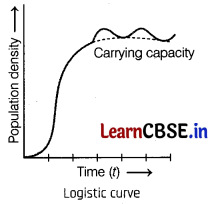
(i) Population initially shows a lag phase and then shows a phase of acceleration or exponential growth followed by phase of deceleration.
(ii) Population can grow exponentially for a certain period of time and then assumes a steady state, as the resource availability becomes limited at some point of time.
(iii) Every environment has resources to support a particular maximum number of individuals, called its carrying capacity. Beyond that, there is no increase in size/density of a population.
(iv) A population showing logistic growth shows a sigmoid curve, when the number of individuals is plotted as a function of time.
(v) Equation can be described as
\(\frac { dN }{ dt }\) = rN(\(\frac { K-N }{ K }\))
Where N = Population density at time t,
r = Intrinsic rate of natural increase,
K = Carrying capacity.
(vi) The model is more realistic in nature, because no population can sustain the exponential growth indefinitely.
Question 100.
(i) Why are herbivores considered similar to predators in the ecological context? Explain.
(ii) Differentiate between the following interspecific interactions in a population.
(a) Mutualism and competition
(b) Commensalism and amensalism (All India 2010)
Answer:
(i) Herbivores feed on plants. They are considered as predators because they also transfer energy across the trophic levels. Besides this, they also keep the population of their prey under control. For example, when the prickly pear cactus was introduced in Australia in early 1920, they spread rapidly causing havoc. Their population was controlled by introducing cactus-feeding predator (a moth).
(ii) (a) Differences between mutualism and competition are
| Mutualism | Competition |
| It benefits both the interacting species. | Both the interacting species suffer. |
| Two individuals may be physically or physiologically associated. | No physical association between competitors. |
| Lichens represent mutualism between fungus and algae, where fungus absorbs nutrition and provides protection, while algae prepares food. | In some South American lakes, visiting flamingoes and resident species compete for the common food. |
(b) Differences between commensalism and amensalism are
| Commensalism | Amensalism |
| Interaction between two species where one species is benefitted and the other is neither harmed nor benefitted. | Interaction between two different species, in which one species is harmed and the other is neither benefitted nor harmed. |
| e.g. an orchid growing as an epiphyte on a mango tree benefits by getting shelter and nutrition but the mango tree is not harmed or benefitted. | e.g. Penicillium produces a toxin killing other microorganisms but is not affected itself. |
Question 101.
(i) Explain with the help of a graph the population growth curve, when resources are (A) limiting (B) not limiting.
(ii) Nature has a carrying capacity for a species. Explain. (Foreign 2010)
Answer:
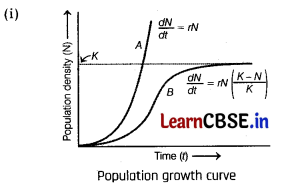
(a) Resources are limiting The population growth curve is sigmoid. It is represented by the equation
dN/dt = rN (\(\frac { K-N }{ K }\))
where,
N = Population density at time t,
r = Intrinsic rate of natural increase
K = Carrying capacity.
(b) Resources are unlimited The population growth curve is J-shaped. It is represented by the equation
dN/dt = rN or N
t
= N
0
e
n
where.
Population density after time t,
N
0
= Population density at time zero
r = Intrinsic rate of natural increase,
e = base of natural logarithm (2.71828).
(ii) The resources become limited at certain point of time. So, no population can grow exponentially. Every environment or habitat has limited resources to support a particular maximum number of individuals. This is called its carrying capacity (K).
![]()
Question 102.
Avik went on an excursion trip with his friends to Ladakh. On reaching the destination, he suddenly experienced heart palpitations, nausea and fatigue. One of his friends suggested him to rest for some time.
(i) Suggest the reasons for the sudden deterioration of health.
(ii) Why did Avik’s friend asked him to rest?
(iii) What value is exhibited by Avik’s friend ?
Answer:
(i) Atmospheric pressure in Ladakh which is at high altitude, is low and hence the body does not get enough oxygen. Avik is suffering from altitude sickness.
(ii) After resting, Avik’s body will get acclimatised to the conditions.
(iii) Values exhibited by Avik’s friend are awareness, caring and helpful nature.